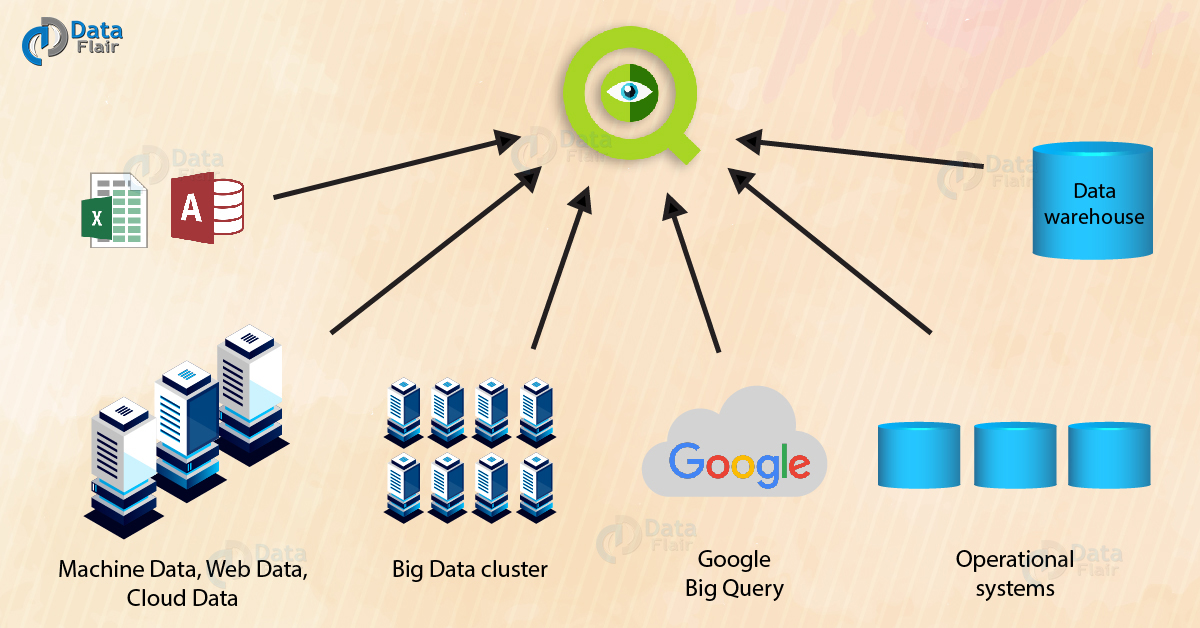Role of QlikView in Big Data – 6 Benefits of QlikView With Big Data
FREE Online Courses: Click, Learn, Succeed, Start Now!
After the Roles and Responsibility of QlikView Developer, we will talk about the roles of Qlikview in Big Data. The profusion of big data into almost every domain of business is a well-known fact in today’s time.
Let us understand the benefits and working of Qlikview in Big Data.
Introduction to Big Data
Well, to simplify it, big data is a reference term used for massive (millions and billions of terabytes) amounts of data floating around in the digital world as information.
Now, what is its significance you ask? Big data contains within it, important information regarding its source of generation and processes.
We can decrypt and analyze Big Data by professionals to gain fresh insights and discover trends/patterns in business. For instance, the data generated by Facebook without a doubt falls into the big data category.
Now, the user data simply getting generated daily, does not serve any purpose. It is still raw and unstructured data.
Similarly, with the plethora of data generated by numerous sites and organizations in different domains like sales, finance, customer information, lifestyle, transactions, production etc.
What is the Role of QlikView in Big Data?
Big data needs to acknowledge and harvest for its potential. Thus, the data analysis and visualization tools like QlikView are needed in order to give context and meaning to the raw data and then represent it to the users.
With the steep increase in big data amounts, technologies and hardware to store it has also evolved. The data storage devices have become cheaper as compared to earlier times and so, storing significant amounts of big data is now easily affordable.
But is storing huge parts of big data enough? Of course not! We also need reporting and analysis tools that utilize this data, process it as per an analytical pathway and procedure to produce meaningful insights from it as a result.
Now, there is a lot of business intelligence and analytics tool in the market which offer big data source compatibility such as QlikView, Tableau, Power BI etc.
However, our focus stays on QlikView and its offerings for working with big data. QlikView enables users to collect and aggregate data into a single data set from various data sources. This makes QlikView a unique tool as this flexibility is not offered by a lot of other BI tools.
How QlikView Handle Big Data?
Using QlikView scripting and visualization tools, you can transform data taken from multiple sources into meaningful information. QlikView imports data from data sources storing big data.
Then, users model and structure raw data into relational database structures through scripting, so that associations and links between data tables are created.
Then this loaded and modeled data is taken up by the UI visualization objects such as graphs, tables, charts to represent it in several ways based on different criterions.
You can accommodate tens of visualization objects on a QlikView dashboard to provide a complete picture of the scenario you are analyzing.
Let us go a step further and get some technical understanding of how QlikView handles big data coming into it.
- There are several components of Qlikview environment, that takes care of different tasks like scheduling reloads, distribution, calculations, data processing etc. Two main components which play an important role in big data handling are QlikView Publisher and QlikView Server.
- As we know, QlikView does not work as a database, rather it just holds a part of the entire data residing in the database in its in-memory for the time being. Whatever data is requested is loaded in QlikView during script execution or reload. Upon running the script, data is imported and transformed according to the modeling instructions in the script.
- From there, the data is available for the visualization objects to use.
We should update Qlikview regularly, to accommodate big data, because there is no live connection with the big data sources.
The QlikView Publisher takes care of this as it schedules timely script reloads and distribution tasks so that the user keeps on getting fresh data. Similarly, the QlikView server manages calculation and processing operations while an application is running.
Benefits of QlikView in Big data
Here, are some reasons as to why QlikView is an effective tool when it comes to dealing with big data.
- QlikView provides complete flexibility to the user by removing predefined analytics paths. The user has the freedom to create their own models and paths to analyze a data set. This opens new avenues in generating new insights into data and discovering new data trends and patterns. This reinforces the idea of business discovery and self-service.
- It offers options like bookmarking for the users to share their reports, dashboards and collaborate with other users across the organization to indulge in collective decision making.
- QlikView provides a coherent data analysis environment as it is a stand-alone software and does not interfere with the functioning of data source systems by importing data from varied sources into its local memory.
- The data in QlikView environment safe as a buffer from outer system malfunctioning.
- In QlikView, users can develop their own visualization and analytic objects. And so, the developers focus only on developing the data models, creating data structures, scheduling data imports etc.
- We can use QlikView applications on any platform such as PCs, iPads, laptops or smartphones.
Summary
Thus, QlikView makes interacting with big data a fast, flexible and easy experience for the users. Although, with the increasing data volumes, the need for new and advances data representation tools arises. Which demands new and updated versions of tools like QlikView.
Did you like our efforts? If Yes, please give DataFlair 5 Stars on Google


